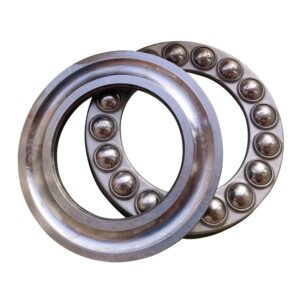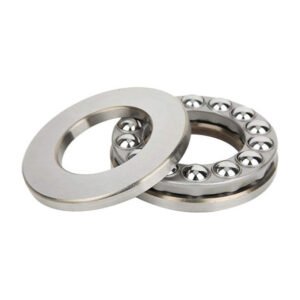Thrust Ball Bearings
Home >> Industrial Bearings >> Ball Bearings >> Thrust Ball Bearings
Have Query?
One of the most common forms of rotary bearing is a thrust bearing. It consists of elements that principally support a spinning device’s capacity to withstand axial loads. The faces of the rings used to join the balls within these bearings are constructed with raceways.
This design element assists in supporting the axial load of the bearing but not radial loads. Consequently, these are not constructed to support moment loads. Depending on the applications of thrust bearings, this kind of bearing is normally assembled with balls and cylindrical, tapered, spherical, or needle rollers, as the case may be.
Features & Benefits of Thrust Ball Bearings
- These consist of two rings, both of which have a racetrack on one of their faces to hold the balls between them.
- To withstand radial loads in either direction, these are used in pairs.
- These perform well in applications where the axial load is lower.
- These are best for high rotational speed operations.
- These can withstand temperatures up to 275°C.
- Since these bearings are self-aligning, the structural misalignment of the device does not affect them.
Types of Thrust Ball Bearings
Small cylindrical rollers are referred to as cylindrical thrust roller bearings. Their axes are oriented in the direction of the axis of the bearing. These are inexpensive and possess a great carrying capacity. But these bearings possess a great deal of friction.
Small tapered rollers are arranged in a way that all their axes meet the axis of the bearing in tapered roller thrust bearings. For smooth running without sliding, the length, angle, and diameter of the rollers need to be accurately measured. But manufacturing them is more expensive.
Spherical roller thrust bearings: The structure utilizes asymmetrical spherical rollers housed in a washer with an inner raceway of spherical form. These can sustain shaft misalignment and combined radial and axial loads. This kind offers the greatest load density due to this. Where a thrust bearing with many rolling components needs minimal height, needle roller thrust bearings are the option of choice. They can sustain very high axial and shock loads and are sometimes fitted without a washer or shaft.
Fluid film thrust bearings: Low drag for high speed applications is provided by a thin but compliant layer of pressurised liquid supporting the axial load.
Magnetic thrust bearings: Axial thrust in these bearings is sustained by a magnetic field, similar to fluid bearings. Ideal for applications involving less drag or very high speeds.
Single-Direction Thrust Ball Bearings
Single-direction thrust ball bearings consist of two washers—a shaft washer and a housing washer—and a single cage that contains the balls. They provide only one direction of axial load support.
Qualities
- Customized design
- The balls are retained in a cage and aligned by an aligning seat washer with a groove.
- Especially designed components
- Shaft washers are washers mounted on the shaft, whereas housing washers are washers mounted on the housing (fixed rings).
- Support axial load
- Single-direction thrust ball bearings allow axial loads to be applied in only one direction.
Applications
Printer, radial drilling equipment, fishing rod, automated guide vehicles (AGVs), ball screw support on precision positioning stage sections
Double-Direction Thrust Ball Bearings
Three washers are used in double-direction push ball bearings, and there are two cages housing the balls. The shaft washer, put between the two cages, accommodates axial stresses in both directions due to it.
Features:
- Unique design
- The balls are guided by the grooved alignment seat washer within a cage.
- Specifically designed components
- Shaft washers and housing washers are the two washer types.
- Offer bidirectional support for axial loads
- Double-direction thrust ball bearings are able to resist axial stresses in both directions, as implied by their name. In order to reduce the effects of mounting difficulties, there are also versions provided with aligning seat washers.
Uses
Press machines, compressors, clutch breakers, disc hubs in farming equipment, vacuum pumps.
Order Your Thrust Ball Bearings Now at Decent Machinery!
Purchase Thrust Ball Bearings from Decent Machinery. Find a range of choices to browse through and select as per your requirement!
Visit our website decentmachinery.com or call us at + (86)15807142157.


